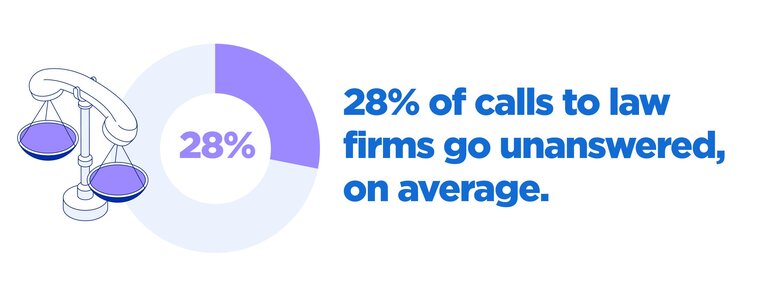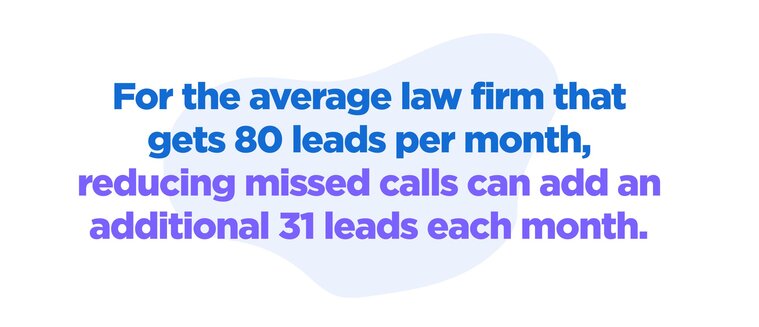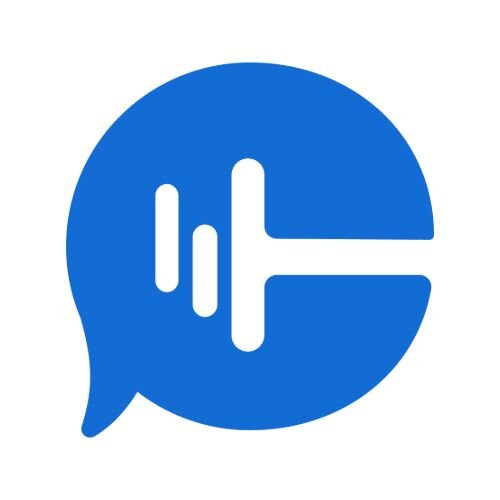Foreward provided by MyCase
Legal technology is evolving faster than ever, creating new opportunities — and challenges — for law firms. With more competition in the industry, clients and prospects now expect quick responses, smooth communication, and a hassle-free intake process. The good news? Firms that adapt can stand out. However, many still find it tough to juggle casework while managing leads and following up with potential clients. The right approach can turn these challenges into a competitive advantage.
Too often, firms focus on increasing marketing budgets to generate more leads when, in reality, the biggest opportunity for growth lies in maximizing existing leads — particularly those coming in via phone. Missed calls aren’t just a minor inconvenience; they represent missed revenue and wasted marketing spend.
With tools like call tracking, automation, and AI-driven follow-up, firms can ensure that every lead is captured, routed to the right person, and responded to quickly.
This article highlights why firms must rethink their approach to missed calls and intake. Instead of spending more on marketing, let’s start by fixing the intake process because the clients are already calling. And with CallRail and MyCase, you’re ready to answer.
When attorneys think about growing their practices, it often means spending more on marketing to get more leads. In our recent report, the 2025 Marketing Outlook for Law Firms, many law firms (nearly 50%) felt they didn’t have the budget to compete with larger firms, while 40% were considering spending more on pay-per-click (PPC) advertising.
But before you increase your Google Ads spend, consider your missed phone call rate. We bet there is a treasure trove of leads in there—potentially worth millions.
Let’s examine the impact of missed calls on your firm’s growth potential and strategies for capturing the leads hidden in those missed calls.
Start thinking of missed calls as missed leads
In the latest legal marketing outlook, we found that half of respondents cannot estimate the number of clients lost annually due to slow responses (let alone no response), and nearly 9 in 10 cannot quantify the associated revenue loss.
News flash: it’s probably a significant amount of revenue (and wasted marketing spend).
Our call insights report reveals that the legal industry has the second highest rate of missed calls of any industry, behind only healthcare, with a 28% missed call rate. Whether people call during the day, after business hours, or on weekends, a portion of those calls are from potential clients.

When a prospective client calls your firm, you’ve likely already invested significant money to get that call—an average of $649 per lead for law firms. Between paid ads, SEO, content marketing, and agency costs, a significant amount of time and money is needed to get the prospect from “never heard of that law firm” to “I’m going to call that law firm for help.” So a missed call isn’t just missed revenue: it’s wasted marketing dollars.
According to the MyCase 2024 Benchmark Report, only 14% of prospective clients attend consultations before retaining a law firm. If your firm misses their call (or takes too long to respond) you may never get the chance to book that crucial consultation in the first place. A missed call isn’t just missed revenue; it’s wasted marketing dollars and lost opportunities to convert leads into paying clients.
Missed calls cost you how much?
Let’s take a look at what the impact of 28% missed calls means for the growth of a hypothetical personal injury law firm, assuming the practice receives 80 leads per month on average with an average settlement of around $55,000.
With this information, we can do some quick math to find how many leads this hypothetical practice is missing out on. So, if 72% of calls are answered, resulting in 80 leads per month, what happens when 100% of calls are answered? The lead count jumps up to 111.
That’s a net increase of 31 leads per month or 372 per year. If each lead is potentially worth $19,500 (35% of $55,000), then that’s a $596,750 monthly revenue bump or $7,161,000 per year.
Of course, not every lead becomes a case, and not every case will settle. The $596,750 per month represents the potential revenue from the firm’s missed calls. Even if they only convert 50% of prospective calls into clients and only 50% of those cases reach a settlement, that’s still an extra $149,188 per month for the firm, or $1.79m per year.
Depending on the size of your firm and practice area, the value hidden in your missed calls will differ. If you know your key metrics—missed call rate, average leads per month, and average case value—you can get a sense of the impact missed calls are having on your practice.

Again, you’re already paying for these leads. Instead of spending more on marketing, let’s start by solving the problem of missed calls and slow follow-up.
How do you solve the problem of missed calls?
To reduce your missed call rate to zero, you’ll need a combination of commonly available technologies: call tracking, automation, and AI. The goal of this tech is to ensure you know as much about your callers as possible so you can quickly route and respond to missed calls.
Study after study shows that the longer you wait to respond to a lead, the less likely you are to convert that lead. Why would a person who is injured on the job and needs to retain a workers’ comp lawyer wait for you to get back to them? Why would a mother seeking custody rights wait?
There are three key pieces to this strategy: identify, route, and respond.
1. Identify the call’s purpose.
Some of those 28% of missed calls will be leads, which is why you need as much insight into every missed call as possible. In the MyCase 2024 Legal Industry Report, 11% of surveyed law firms stated that tracking online leads is one of the most challenging functions at their firm. Without proper tracking, it’s nearly impossible to know which marketing efforts are actually driving new business and which calls are slipping through the cracks. The right call tracking technology provides key insights to facilitate the intake process for new leads, such as the keywords and campaigns that led them to call, a great indicator for why a lead may reach out.
With call tracking providing the foundation, you can add automation and AI insights. An AI-powered tool like Premium Conversation Intelligence™ can deliver accurate transcripts of every phone call and, if you miss calls, voicemails. From there, you can create automation based on keywords you set. You can set keywords relevant to your practice (slip-and-fall, car accident, DUI, etc.) or keywords that indicate urgency (as soon as possible, call me back, etc.) to identify a potential lead.
2. Route the call to the right person.
Automation can also help you reduce the time it takes to manage your increased call volume.
When a call comes in, you need to ensure it gets to the right person (or at least an available person). You can build call flows and call routing with call management solutions and choose how incoming calls are handled based on the caller’s location or keywords from the voicemail through Premium Conversation Intelligence. For example, a first-time caller can be automatically routed to a particular team member based on a keyword, or an interactive voice response (IVR) system can be set up to let callers choose their destination.
For off-hours calls, you can set up a voicemail-to-email rule that automatically sends a high-quality transcript to your inbox for review, allowing you to identify and respond to high-value leads ASAP. CallRail can even identify leads for you with automation rules that can qualify a lead based on keywords in the conversation. That way, the right person can be alerted as soon as possible to follow up.
3. Respond quickly and intelligently.
A fast response, even if it’s just acknowledging the inquiry, shows the prospective client you’re there for them and that their case is important.
Many law firms are already embracing texting as a client communication tool—58% of law firms use an online texting tool to engage with clients more efficiently. If your firm is already using text messaging for client updates and case management, why not extend that strategy to lead follow-up? Automated text responses ensure that potential clients don’t feel ignored, increasing the likelihood of converting them into paying clients.
With technology like CallRail, you can set up automated responses for every missed call. After a call is missed, you can send a customized text with a message acknowledging the call and a promise to respond as soon as possible. Pair this with MyCase’s built-in text messaging feature, and following up has never been easier.
Once you start capturing these missed calls and keep them from moving on to competitors, your intake team will have more leads to follow up with. That’s where CallRail’s Convert Assist can help you scale up your potential without needing to add more resources.
Convert Assist is an AI-powered tool that can automatically create an action plan with the next steps based on the conversation, ensuring nothing slips through the cracks. With smart follow-up, Convert Assist can help generate customized messages to follow up quickly via text or email. By making it easier to follow up with every lead, your team will be able to handle the increased volume.
Capture the revenue hiding in your missed calls with CallRail
CallRail is a complete solution for solving your missed call challenges. The combination of Call Tracking with automation and AI-powered tools will let you easily identify and respond to leads you would otherwise lose to your competitors.
See what CallRail can do for your firm’s growth with a free 14-day trial, and learn about the powerful CallRail and MyCase integration here.




















%22%2C%22Id%22%3A%2233%22%7D%2C%22Var%22%3A%7B%22Name%22%3A%22Website%22%2C%22Id%22%3A%221%22%7D%2C%22U%22%3A%22D599F87E65466486FFE029105603E8B33%22%7D%2C%7B%22Exp%22%3A%7B%22Name%22%3A%22Signups%22%2C%22Id%22%3A%2242%22%7D%2C%22Var%22%3A%7B%22Name%22%3A%22Website%22%2C%22Id%22%3A%221%22%7D%2C%22U%22%3A%22D599F87E65466486FFE029105603E8B33%22%7D%2C%7B%22Exp%22%3A%7B%22Name%22%3A%22Homepage%20Trial%20Clicks%22%2C%22Id%22%3A%2284%22%7D%2C%22Var%22%3A%7B%22Name%22%3A%22Website%22%2C%22Id%22%3A%221%22%7D%2C%22U%22%3A%22D599F87E65466486FFE029105603E8B33%22%7D%2C%7B%22Exp%22%3A%7B%22Name%22%3A%22Sitewide%20Trial%20Clicks%22%2C%22Id%22%3A%2285%22%7D%2C%22Var%22%3A%7B%22Name%22%3A%22Website%22%2C%22Id%22%3A%221%22%7D%2C%22U%22%3A%22D599F87E65466486FFE029105603E8B33%22%7D%2C%7B%22Exp%22%3A%7B%22Name%22%3A%22Pricing%20Trial%20Clicks%22%2C%22Id%22%3A%2286%22%7D%2C%22Var%22%3A%7B%22Name%22%3A%22Website%22%2C%22Id%22%3A%221%22%7D%2C%22U%22%3A%22D599F87E65466486FFE029105603E8B33%22%7D%5D%7D&_biz_u=ee3d694ca37645a1a23c3abd7c61d3ad&_biz_l=https%3A%2F%2Fwww.callrail.com%2Fblog%2Fhow-missed-calls-cost-law-firm&_biz_t=1743085676134&_biz_i=null&_biz_n=10&rnd=538371&cdn_o=a&_biz_z=1743085676134)
%22%2C%22Id%22%3A%2232%22%7D%2C%22Var%22%3A%7B%22Name%22%3A%22Website%22%2C%22Id%22%3A%221%22%7D%2C%22U%22%3A%22D599F87E65466486FFE029105603E8B33%22%7D%2C%7B%22Exp%22%3A%7B%22Name%22%3A%22Clicks%20start%20free%20trial%20(home%20page)%22%2C%22Id%22%3A%2233%22%7D%2C%22Var%22%3A%7B%22Name%22%3A%22Website%22%2C%22Id%22%3A%221%22%7D%2C%22U%22%3A%22D599F87E65466486FFE029105603E8B33%22%7D%2C%7B%22Exp%22%3A%7B%22Name%22%3A%22Signups%22%2C%22Id%22%3A%2242%22%7D%2C%22Var%22%3A%7B%22Name%22%3A%22Website%22%2C%22Id%22%3A%221%22%7D%2C%22U%22%3A%22D599F87E65466486FFE029105603E8B33%22%7D%2C%7B%22Exp%22%3A%7B%22Name%22%3A%22Homepage%20Trial%20Clicks%22%2C%22Id%22%3A%2284%22%7D%2C%22Var%22%3A%7B%22Name%22%3A%22Website%22%2C%22Id%22%3A%221%22%7D%2C%22U%22%3A%22D599F87E65466486FFE029105603E8B33%22%7D%2C%7B%22Exp%22%3A%7B%22Name%22%3A%22Sitewide%20Trial%20Clicks%22%2C%22Id%22%3A%2285%22%7D%2C%22Var%22%3A%7B%22Name%22%3A%22Website%22%2C%22Id%22%3A%221%22%7D%2C%22U%22%3A%22D599F87E65466486FFE029105603E8B33%22%7D%2C%7B%22Exp%22%3A%7B%22Name%22%3A%22Pricing%20Trial%20Clicks%22%2C%22Id%22%3A%2286%22%7D%2C%22Var%22%3A%7B%22Name%22%3A%22Website%22%2C%22Id%22%3A%221%22%7D%2C%22U%22%3A%22D599F87E65466486FFE029105603E8B33%22%7D%5D%7D&_biz_u=ee3d694ca37645a1a23c3abd7c61d3ad&_biz_l=https%3A%2F%2Fwww.callrail.com%2Fblog%2Fhow-missed-calls-cost-law-firm&_biz_t=1743085676139&_biz_i=null&_biz_n=11&rnd=601401&cdn_o=a&_biz_z=1743085676139)
%22%2C%22Id%22%3A%2232%22%7D%2C%22Var%22%3A%7B%22Name%22%3A%22Website%22%2C%22Id%22%3A%221%22%7D%2C%22U%22%3A%22D599F87E65466486FFE029105603E8B33%22%7D%2C%7B%22Exp%22%3A%7B%22Name%22%3A%22Clicks%20start%20free%20trial%20(home%20page)%22%2C%22Id%22%3A%2233%22%7D%2C%22Var%22%3A%7B%22Name%22%3A%22Website%22%2C%22Id%22%3A%221%22%7D%2C%22U%22%3A%22D599F87E65466486FFE029105603E8B33%22%7D%2C%7B%22Exp%22%3A%7B%22Name%22%3A%22Signups%22%2C%22Id%22%3A%2242%22%7D%2C%22Var%22%3A%7B%22Name%22%3A%22Website%22%2C%22Id%22%3A%221%22%7D%2C%22U%22%3A%22D599F87E65466486FFE029105603E8B33%22%7D%2C%7B%22Exp%22%3A%7B%22Name%22%3A%22Homepage%20Trial%20Clicks%22%2C%22Id%22%3A%2284%22%7D%2C%22Var%22%3A%7B%22Name%22%3A%22Website%22%2C%22Id%22%3A%221%22%7D%2C%22U%22%3A%22D599F87E65466486FFE029105603E8B33%22%7D%2C%7B%22Exp%22%3A%7B%22Name%22%3A%22Sitewide%20Trial%20Clicks%22%2C%22Id%22%3A%2285%22%7D%2C%22Var%22%3A%7B%22Name%22%3A%22Website%22%2C%22Id%22%3A%221%22%7D%2C%22U%22%3A%22D599F87E65466486FFE029105603E8B33%22%7D%2C%7B%22Exp%22%3A%7B%22Name%22%3A%22Pricing%20Trial%20Clicks%22%2C%22Id%22%3A%2286%22%7D%2C%22Var%22%3A%7B%22Name%22%3A%22Website%22%2C%22Id%22%3A%221%22%7D%2C%22U%22%3A%22D599F87E65466486FFE029105603E8B33%22%7D%5D%7D&_biz_u=ee3d694ca37645a1a23c3abd7c61d3ad&_biz_l=https%3A%2F%2Fwww.callrail.com%2Fblog%2Fhow-missed-calls-cost-law-firm&_biz_t=1743085676143&_biz_i=null&_biz_n=12&rnd=596737&cdn_o=a&_biz_z=1743085676143)
%22%2C%22Id%22%3A%2232%22%7D%2C%22Var%22%3A%7B%22Name%22%3A%22Website%22%2C%22Id%22%3A%221%22%7D%2C%22U%22%3A%22D599F87E65466486FFE029105603E8B33%22%7D%2C%7B%22Exp%22%3A%7B%22Name%22%3A%22Clicks%20start%20free%20trial%20(home%20page)%22%2C%22Id%22%3A%2233%22%7D%2C%22Var%22%3A%7B%22Name%22%3A%22Website%22%2C%22Id%22%3A%221%22%7D%2C%22U%22%3A%22D599F87E65466486FFE029105603E8B33%22%7D%2C%7B%22Exp%22%3A%7B%22Name%22%3A%22Signups%22%2C%22Id%22%3A%2242%22%7D%2C%22Var%22%3A%7B%22Name%22%3A%22Website%22%2C%22Id%22%3A%221%22%7D%2C%22U%22%3A%22D599F87E65466486FFE029105603E8B33%22%7D%2C%7B%22Exp%22%3A%7B%22Name%22%3A%22Homepage%20Trial%20Clicks%22%2C%22Id%22%3A%2284%22%7D%2C%22Var%22%3A%7B%22Name%22%3A%22Website%22%2C%22Id%22%3A%221%22%7D%2C%22U%22%3A%22D599F87E65466486FFE029105603E8B33%22%7D%2C%7B%22Exp%22%3A%7B%22Name%22%3A%22Sitewide%20Trial%20Clicks%22%2C%22Id%22%3A%2285%22%7D%2C%22Var%22%3A%7B%22Name%22%3A%22Website%22%2C%22Id%22%3A%221%22%7D%2C%22U%22%3A%22D599F87E65466486FFE029105603E8B33%22%7D%2C%7B%22Exp%22%3A%7B%22Name%22%3A%22Pricing%20Trial%20Clicks%22%2C%22Id%22%3A%2286%22%7D%2C%22Var%22%3A%7B%22Name%22%3A%22Website%22%2C%22Id%22%3A%221%22%7D%2C%22U%22%3A%22D599F87E65466486FFE029105603E8B33%22%7D%5D%7D&_biz_u=ee3d694ca37645a1a23c3abd7c61d3ad&_biz_l=https%3A%2F%2Fwww.callrail.com%2Fblog%2Fhow-missed-calls-cost-law-firm&_biz_t=1743085676146&_biz_i=null&_biz_n=13&rnd=950647&cdn_o=a&_biz_z=1743085676146)